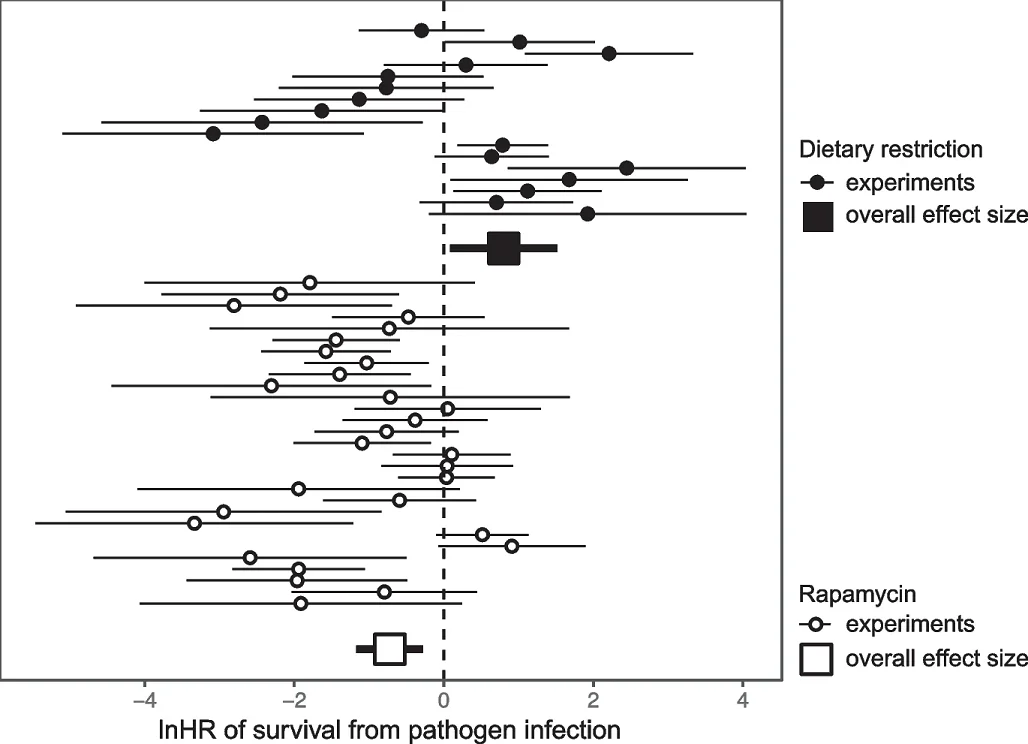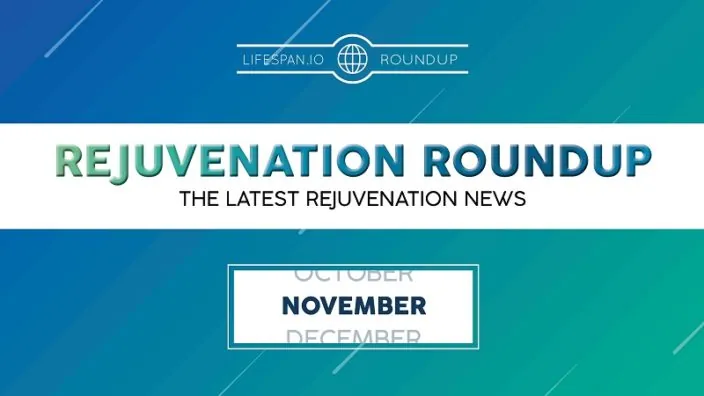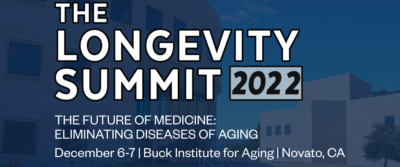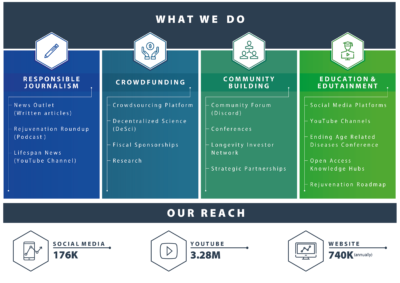The giving season is upon us once more! This month, we focus on November’s research, industry news, and ways that you can help hasten the defeat of aging.
LEAF News
Lifespan.io Presents at MIRAI 2.0 R&I Week 2022: At MIRAI 2.0 Research and Innovation Week 2022, Larisa Sheloukhova joined Swedish and Japanese researchers in discussing future-focused innovations related to aging.
 Raising Awareness that Aging is a Problem Worth Solving: There has been plenty going on here at Lifespan.io, so we thought it was time to give you a little update on what’s been happening.
Raising Awareness that Aging is a Problem Worth Solving: There has been plenty going on here at Lifespan.io, so we thought it was time to give you a little update on what’s been happening.
Lifespan News
Ground Coffee for Longevity: On this episode of Lifespan News, Ryan O’Shea discusses a new longitudinal study showing that drinking a few cups of coffee a day is associated with longer lifespans in human beings.
 Olive Oil for Longevity: Olive oil is a popular diet component for people who seek to live longer. Olive oil is widely considered to be healthier than most other oils and fats, and for good reason, but some of its health benefits are exaggerated.
Olive Oil for Longevity: Olive oil is a popular diet component for people who seek to live longer. Olive oil is widely considered to be healthier than most other oils and fats, and for good reason, but some of its health benefits are exaggerated.
NMN and the FDA: On this episode of Lifespan News, Ryan O’Shea talks about a controversial decision by the Food and Drug Administration to restrict the sale of NMN as a supplement. NMN is popular among longevity enthusiasts and biohackers who take it for its potential, but as yet unproven, longevity benefits.
 Exercise, Cancer, and Rapamycin: We discuss a new study revealing the effects of exercise on cancer and how rapamycin might actually reduce this benefit. Physical activity provides many health benefits, and it can even lower the risk of developing cancer. Now, scientists may have additional evidence of another benefit.
Exercise, Cancer, and Rapamycin: We discuss a new study revealing the effects of exercise on cancer and how rapamycin might actually reduce this benefit. Physical activity provides many health benefits, and it can even lower the risk of developing cancer. Now, scientists may have additional evidence of another benefit.
Interviews
Lou Hawthorne, NaNotics on Cleaning Blood with Nanoparticles: Lou Hawthorne is the founder and CEO of NaNotics, a biotech company that creates nanoparticles that can soak up harmful molecules in circulation. This paradigm-shifting technology can be used to fight cancer as well as various inflammatory disorders, such as sepsis, which kills more people than cancer does.
 Dr. Matt Kaeberlein on WormBot and the Dog Aging Project: Dr. Matt Kaeberlein is a heavy hitter in the longevity field. While his name has become associated with the Dog Aging Project that he started a few years ago, his research interests span much wider.
Dr. Matt Kaeberlein on WormBot and the Dog Aging Project: Dr. Matt Kaeberlein is a heavy hitter in the longevity field. While his name has become associated with the Dog Aging Project that he started a few years ago, his research interests span much wider.
Rejuvenation Roundup Podcast
Ryan O’Shea of Future Grind hosts this month’s podcast, showcasing the events and research discussed here.
Journal Club
Rapamycin extends life span & health span in mice & Daphnia: The Journal Club returned on our Facebook channel. Dr. Medvedik took a look at the recent paper entitled “Rapamycin treatment during development extends life span and health span of male mice and Daphnia magna”.
Advocacy and Analysis
New Initiative for a More Longevity-Friendly World: Quantum Healthy Longevity Innovation Mission is a new UK-based initiative touting a multi-pronged approach to push for longer lifespans and healthspans for everyone.
 We Can Think of Worse Curses, Elon Musk: Two days ago, famous billionaire and new Twitter owner Elon Musk Tweeted that he cannot think of a worse curse than living forever, in reply to a Tweet relating to the predicted heat death of the universe.
We Can Think of Worse Curses, Elon Musk: Two days ago, famous billionaire and new Twitter owner Elon Musk Tweeted that he cannot think of a worse curse than living forever, in reply to a Tweet relating to the predicted heat death of the universe.
Making Good Financial Decisions for Longevity: In a preprint published in Social Science Research Network, researchers have shown that it might be possible to protect people from making poor financial decisions earlier in life by providing them objective longevity information.
Research Roundup
Cellular Reprogramming Extends Lifespan, Healthspan in Mice: Scientists have shown that continuous low-dose induction of reprogramming factors and a single early life reprogramming treatment both significantly increase lifespan and healthspan in progeroid mice while altering their epigenetic landscape.
 Klotho Reduces Arterial Calcification Through Autophagy: In a new study published in Oxidative Medicine and Cellular Longevity, the researchers have shown that klotho ameliorates vascular calcification via increased autophagy. Vascular calcification, the deposition of minerals in the cardiovascular system, is a complex pathological process that accompanies aging.
Klotho Reduces Arterial Calcification Through Autophagy: In a new study published in Oxidative Medicine and Cellular Longevity, the researchers have shown that klotho ameliorates vascular calcification via increased autophagy. Vascular calcification, the deposition of minerals in the cardiovascular system, is a complex pathological process that accompanies aging.
Protecting Memory Through Gut Bacteria: Researchers publishing in Nutrients have shown that adding a strain of lactic acid bacteria to the gut flora of older, memory-impaired people partially alleviates their memory problems.
 Gene Therapy to Delay Reproductive Senescence: A team of Spanish researchers publishing in Aging have reported that they can delay reproductive senescence in female rats by stimulating the production of insulin growth factor 1 (IGF-1) through gene therapy.
Gene Therapy to Delay Reproductive Senescence: A team of Spanish researchers publishing in Aging have reported that they can delay reproductive senescence in female rats by stimulating the production of insulin growth factor 1 (IGF-1) through gene therapy.
Extracellular Vesicles from Young Stem Cells Rejuvenate Mice: Scientists have shown that injection of extracellular vesicles secreted by young adipose-derived stem cells increases fitness and promotes tissue rejuvenation in aged mice.
 Astaxanthin Improves Endurance in Older Adults: In a new study published in International Journal of Environmental Research and Public Health, Japanese researchers have shown that astaxanthin supplementation improves endurance in healthy older adults.
Astaxanthin Improves Endurance in Older Adults: In a new study published in International Journal of Environmental Research and Public Health, Japanese researchers have shown that astaxanthin supplementation improves endurance in healthy older adults.
Harnessing Senescent Cancer Cells to Fight Cancer: New research published in Cancer Discovery has outlined a potential new method of using senescent cells to encourage the immune system to attack cancer.
Correlation Between Cognitive Decline and Epigenetic Clocks: Researchers publishing in Aging have found a correlation between cognitive decline and measurements of epigenetic aging. An epigenetic clock is a biochemical test that uses DNA methylation levels and accumulation of methyl groups on DNA to determine biological age.
 Protein Intake Increases Bone Density in Older Adults: Scientists have found that animal protein consumption positively correlates with bone density in older adults. Things become more complicated regarding plant protein.
Protein Intake Increases Bone Density in Older Adults: Scientists have found that animal protein consumption positively correlates with bone density in older adults. Things become more complicated regarding plant protein.
The Effects of Niacin on Alzheimer’s in Mice: A study published in the Annals of Translational Medicine has shown the effects of niacin supplementation on a mouse model of Alzheimer’s and outlined the genes involved.
 Arginase Inhibitor Improves “Leaky Gut” in Old Mice: According to a new study, the age-related increase in intestinal permeability that drives inflammation can be alleviated by inhibiting the enzyme arginase, a regulator of nitric oxide production.
Arginase Inhibitor Improves “Leaky Gut” in Old Mice: According to a new study, the age-related increase in intestinal permeability that drives inflammation can be alleviated by inhibiting the enzyme arginase, a regulator of nitric oxide production.
Protein Content in an Optimal Diet: In a new study published in Nature Communications, researchers have designed guidelines for dietary amino acid consumption for optimal health.
 Muscle Strength Associated with Oral Health: Researchers publishing in The Lancet have found a relationship between poor oral health and weaker muscles in people who are at least 70 years old.
Muscle Strength Associated with Oral Health: Researchers publishing in The Lancet have found a relationship between poor oral health and weaker muscles in people who are at least 70 years old.
Nicotinamide Riboside May Make Existing Cancer Worse: A paper published in the journal Biosensors and Bioelectronics has caused a stir in the longevity community by showing that nicotinamide riboside (NR), a precursor to NAD+, makes tumors more aggressive in a mouse model.
 Exercise Might Protect from Metastatic Cancer: In a new study published in the journal Cancer Research, Israeli scientists have found that by increasing the metabolic activity of healthy cells, exercise likely pitches them against cancer cells in a battle for nutrients, which slows cancer progression.
Exercise Might Protect from Metastatic Cancer: In a new study published in the journal Cancer Research, Israeli scientists have found that by increasing the metabolic activity of healthy cells, exercise likely pitches them against cancer cells in a battle for nutrients, which slows cancer progression.
Rapamycin Improves the Viability of Egg Cells: Researchers publishing in Aging have found that rapamycin, a molecule thoroughly researched for its effects on metabolism, improves the viability of egg cells (oocytes) grown in vitro. Decreased fertility in women occurs much more rapidly than other aspects of aging.
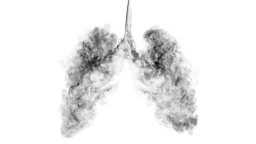 Air Pollution Harms Immune Function in Lungs: A new study published in Nature Medicine suggests that lifelong exposure to tiny airborne particles leads to their accumulation in lymph nodes in the lungs and to impaired immune function. With age, people become more susceptible to many diseases, with the lungs being one of the most affected organs.
Air Pollution Harms Immune Function in Lungs: A new study published in Nature Medicine suggests that lifelong exposure to tiny airborne particles leads to their accumulation in lymph nodes in the lungs and to impaired immune function. With age, people become more susceptible to many diseases, with the lungs being one of the most affected organs.
How much resistance exercise is beneficial for healthy aging and longevity?: Although these analyses demonstrated an overall inverse association between resistance exercise and mortality risk from all causes and/or from cardiovascular diseases, diabetes, and cancers, this was only true up to a certain threshold.
Effects of nicotinamide mononucleotide on older patients with diabetes and impaired physical performance: A prospective, placebo-controlled, double-blind study: In older male patients with diabetes and impaired physical performance, NMN supplementation for 24 weeks was safe, but did not improve grip strength and walking speed.
Genistein effect on cognition in prodromal Alzheimer’s disease patients. The GENIAL clinical trial: This study shows that genistein may have a role in therapeutics to delay the onset of Alzheimer’s dementia in patients with prodromal Alzheimer’s disease.
Bioactive Yoghurt Containing Curcumin and Chlorogenic Acid Reduces Inflammation in Postmenopausal Women: Bioactive yoghurt fortified with curcumin and chlorogenic acid has the potential to reduce inflammatory mediators; however, a larger and longer-term study is required to confirm these findings.
Impact of probiotics on muscle mass, muscle strength and lean mass: a systematic review and meta-analysis of randomized controlled trials: Probiotic supplementation enhances both muscle mass and global muscle strength; however, no beneficial effects were observed in total lean mass.
Rapamycin not dietary restriction improves resilience against pathogens: a meta-analysis: Rapamycin treatment significantly increased post-infection survival rate, while dietary restriction reduced post-infection survival. These results show that immunomodulation caused by rapamycin treatment is beneficial to survival from acute infection.
Comparative Effects of Low-Dose Rosuvastatin, Placebo and Dietary Supplements on Lipids and Inflammatory Biomarkers: Among individuals with increased 10-year risk for atherosclerotic cardiovascular disease, rosuvastatin 5 mg daily lowered harmful cholesterol significantly more than placebo, fish oil, cinnamon, garlic, turmeric, plant sterols, and red yeast rice.
Positive social factors prospectively predict younger epigenetic age: Findings from the Health and Retirement Study: Perceived support from and contact with close others, particularly friends, may have implications for healthy biological aging. Notably, the effect sizes for friends were comparable to the effect of body mass index on epigenetic age.
In vivo partial reprogramming by bacteria promotes adult liver organ growth without fibrosis and tumorigenesis: Mycobacterium leprae infection of adult nine-banded armadillos promotes in vivo liver growth. Enlarged infected livers are functionally and architecturally normal without tumors, partial reprogramming to progenitor/regeneration state drives liver growth, and bypassing of normal liver growth restriction offers safer repair interventions.
Autologous NK cells propagated and activated ex vivo decrease senescence markers in human PBMCs: Activated NK cells decrease senescent cells in vitro and immunosenescence in humans based on the biomarkers p16 and β-galactosidase.
Glutaminase inhibitors rejuvenate human skin via clearance of senescent cells: a study using a mouse/human chimeric model: Selective removal of senescent dermal fibroblasts can improve the skin aging phenotype, indicating that the glutaminase inhibitor BPTES may be an effective novel therapeutic agent for skin aging.
Unsupervised learning of aging principles from longitudinal data: The AI-developed dynamic frailty indicator changed along with hallmarks of aging, including frailty index, molecular markers of inflammation, senescent cell accumulation, and responded to life-shortening (high-fat diet) and life-extending (rapamycin) treatments.
Deep phenotyping and lifetime trajectories reveal limited effects of longevity regulators on the aging process in C57BL/6J mice: Many putative anti-aging interventions influence phenotypes long before the onset of detectable age-dependent change but, importantly, do not alter the rate of phenotypic change. Hence, they have limited effects on aging.
Is life expectancy higher in countries and territories with publicly funded health care? Global analysis of health care access and the social determinants of health: These findings demonstrate how, if made widely available, publicly funded health care could extend longevity of life. If combined with programs to reduce the burden of social determinants, a substantial impact can be made to promote more equitable distribution of life expectancies across the world.
Aging, Equality and the Human Healthspan: The author responds to a previous paper, stating that an intervention that slows down the rate of molecular and cellular decline from the inborn aging process will likely be one of the most important public health advancements of the twenty-first century.
Cellular enlargement – A new hallmark of aging?: Taken together, the researchers found mounting evidence linking cellular enlargement to aging and age-related diseases. Therefore, they encourage researchers from seemingly unrelated areas to take a fresh look at their data from the perspective of cell size.
News Nuggets
 The Quantum Healthy Longevity Innovation Mission Launches: The National Innovation Centre for Ageing and Collider Health launch the Quantum Healthy Longevity Innovation Mission with a keynote by Lord Bethell, former Parliamentary Under Secretary of State for Technology, Innovation and Life Sciences, to shift ‘sickcare’ to a new model based on proactive prevention.
The Quantum Healthy Longevity Innovation Mission Launches: The National Innovation Centre for Ageing and Collider Health launch the Quantum Healthy Longevity Innovation Mission with a keynote by Lord Bethell, former Parliamentary Under Secretary of State for Technology, Innovation and Life Sciences, to shift ‘sickcare’ to a new model based on proactive prevention.
Longevity Biotech Fellowship Announces Launch: On Deck Longevity Biotech and the founders of LessDeath.org have collaborated to start the Longevity Biotech Fellowship, a new initiative focusing on bringing upcoming professionals into the longevity industry.
 FDA Purges NMN From the List of Supplements: Reversing its own earlier decision, the FDA has informed an NMN manufacturer that the molecule can no longer be marketed as part of dietary supplements. Another company that is testing NMN as a drug probably contributed to the decision, which is not being enforced as of now.
FDA Purges NMN From the List of Supplements: Reversing its own earlier decision, the FDA has informed an NMN manufacturer that the molecule can no longer be marketed as part of dietary supplements. Another company that is testing NMN as a drug probably contributed to the decision, which is not being enforced as of now.
We would like to ask you a small favor. We are a non-profit foundation, and unlike some other organizations, we have no shareholders and no products to sell you. All our news and educational content is free for everyone to read, but it does mean that we rely on the help of people like you. Every contribution, no matter if it’s big or small, supports independent journalism and sustains our future.







